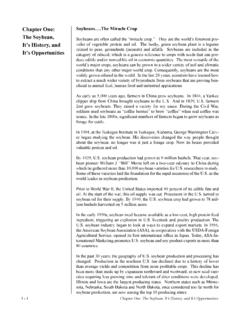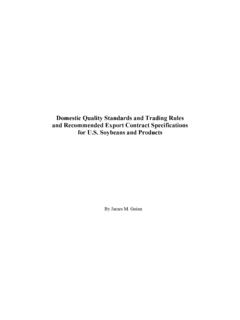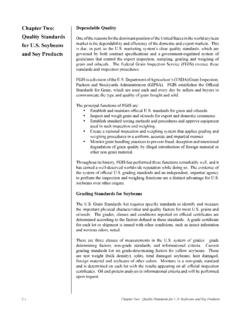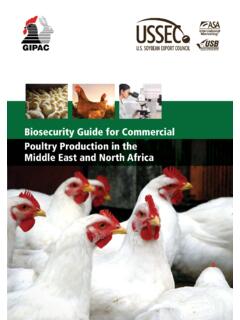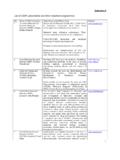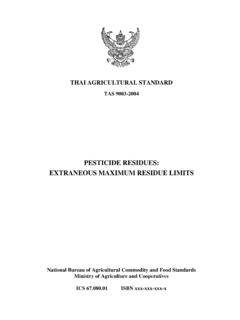Transcription of Manual of Quality Analyses - U.S. Soybean Export …
1 Manual of Quality Analyses . for Soybean PRODUCTS in the feed INDUSTRY. 2nd Edition. van Eys, GANS Inc., 24 Av. de la Guillemote, 78112 Fourqueux, France ; CONTENTS. A. Introduction A-1. List of Abbreviations A-2. B. Soybeans, Soybean products and production processes B-1. C. Definitions and applications of soybeans and soy products C-1. D. Chemical and nutritional composition of Soybean products D-1. E. Official standards of some Soybean products E-1. F. Sampling soy products F-1. G. Physical evaluation and equipment G-1. H. Chemical Analyses H-1. Moisture H-2. Ash H-3. Protein H-4. Protein Quality H-6. Urease Index KOH protein solubility Protein Dispersibility Index (PDI).
2 Protein Quality in ruminants In situ technique In vitro technique Amino acids H-12. Crude fiber (CF) H-13. Neutral Detergent Fiber (NDF) H-14. Acid Detergent Fiber (ADF) H-15. Lignin H-16. Klason lignin Permanganate lignin Starch H-17. Polarimetric starch determination Enzymatic or colorimetric starch determination Non Starch Polysaccharides (NSP) and Monosaccharides H-20. Ether Extracts (EE) H-22. Lipid Quality H-23. Moisture Insoluble impurities Unsaponifiable matter Iodine value (IV). Acid value Lipid oxidation Peroxide value Thiobarbituric acid (TBA). Anisidine value Lipid stability tests AOM (Active Oxygen Method). OSI (Oil Stability Index).
3 Fatty acid profile H-30. Calcium Phosphorus Sodium chloride Iso-flavones H-33. Anti-nutritional factors H-34. Trypsin inhibitors Soy antigens Lectins ; rapid tests H-40. Ochratoxin Zearalenone Fumonisins Aflatoxins Deoxynivalenol Modified Organisms (GMO). I. NIR Analyses I-1. J. Full fat soybeans (FFSB) J-1. K. Data management K-1. Sample statistics K-1. Quality indicators K-4. Significance of parameter estimates K-6. Control charts K-8. Follow-up and application of analytical results K-10. Appendices References LIST OF FIGURES AND TABLES. Figures 1 Schematic representation of the manufacturing of Soybean products. B-2.. 2 Protein disappearance from Soybean meal and curve peeling process H-11.
4 3 Auto-oxidation of linolenic acid. H-27. 4 Example of a density curve describing a normal distribution. K-1. 5 Histogram of the data based on seven intervals. K-4. 6 Definition of accuracy versus precision. K-4. 7 Control chart for protein content (% of DM) Analyses in Soybean meal samples. K-10. Tables 1 Description and classification of Soybean products. C-2. 2 Application of Soybean products. C-6. 3 Composition of some soy protein ingredients used in animal feeds. D-2. 4 Analytical characteristics of common types of soy protein products. D-3. 5 grades and grade requirements for soybeans. E-2. 6 grades and grade requirements for soybeans.
5 E-3. 7 Recommended additional specifications for Soybean meal. E-3. 8 Standards for edible crude de-gummed Soybean oil and vegetable oils E-4. in animal feed . 9 Effect of heat processing on amino acid digestibility of raw soybeans in poultry. H-6. 10 Effect of heat-processing Soybean meals on amino acid concentration H-6. 11 Comparison of three laboratory techniques to determine under-processing or H-7. correct processing of commercial Soybean meals. 12 Effect of autoclaving Soybean meal on chick performance (1-18 days), KOH protein H-8. solubility and urease activity. 13 A brief description of available methods to determine protein Quality of H-9.
6 Soybean meal. 14 Optical rotation of various pure starch sources. H-19. 15 Solutions to prepare standard curve for colorimetric starch determination. H-20. 16 Dilution scheme for the trypsin inhibitor activity determination by the H-38. ISO (2001) method. 17 ELISA formats used for analysis of soy globulins. H-39. 18 Anti-nutritional factor contents in various soy products. H-39. 19 Extrusion temperature of FFSB, trypsin inhibitors, and performance J-2. of broiler chickens . 20 Extrusion temperatures of FFSB, in vivo digestible amino acid coefficients, and J-2. KOH protein solubility. 21 Apparent ileal amino acid digestibility coefficients in broiler chickens fed FFSB J-3.
7 Containing different concentrations of TIA. 22 Common notation of parameters and parameter estimates. K-2. 23 Protein content of Soybean meal: calculation steps to determine the mean K-3. and variance. 24 Typical ranges and acceptable coefficients of variation for proximate analysis K-5. in feedstuffs. 25 Error types in hypothesis testing. K-7. 26 Protein content (% of DM) in Soybean meal samples. K-9. Manual OF SOY Quality Analyses . A. INTRODUCTION. The use of Soybean products in the feed and food industry has increased steadily over the past decades. Of the total world production of soybeans, more than 90% is directly used for animal consumption.
8 The overwhelming majority is used in animal feed in the form of various types of Soybean meals or specialty soy products. The current world production of Soybean meal is estimated to be in excess of 182 million metric tons which amounts to approximately 69% of all the major protein meals (USDA, 2011). With global compound feed estimates at well over 700 million Metric Tons Best, (2010) Soybean meals represent the dominant source of protein in animal diets. However, total use and importance of soybeans or Soybean products is likely to be higher than indicated by major statistics as a plethora of different Soybean products are entering the feed and food chain.
9 This dominant position of soybeans and their products is no doubt associated with their high Quality especially with respect to protein and amino acid profile. Following proper treatment or extraction, digestibility of the protein fraction is high and the amino acid profile provides a close match with cereals to meet animal requirements. Nevertheless, in their untreated form, soybeans contain a number of factors that have the potential to diminish their nutritive value - to the point of decreasing animal performance and health (Liener, 2000). A treatment of soybeans to eliminate these anti nutritional factors (ANF) is thus necessary especially in the case of monogastric diets.
10 These treatments, combined with varietal differences in the production process of Soybean meals or other products lead to potentially large variations in Quality . While basic standard specifications for Soybean meals have been established (NOPA, 2011) no official specifications exist for other soy products that are routinely used in the feed industry. Furthermore the NOPA specifications only refer to four chemical characteristics. Current evaluations of soy products by industry nutritionists and formulators are based on a much larger array of tests allowing a more accurate evaluation of the nutritive value of the different products. However, under practical conditions of feed production the choice of tests differ greatly among producers and feed compounders and not all tests are applied on a regular basis (West, 2002).
